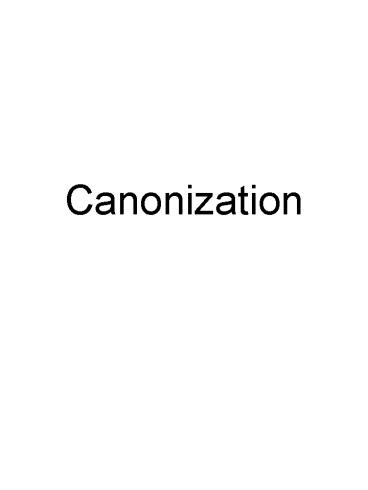Canonization - PowerPoint PPT Presentation
1 / 12
Title:
Canonization
Description:
Within Christianity there are different books included in the 'Old Testament' ... 1 Book of Acts (stories of the spread of early Christianity) 21 Epistles (letters) ... – PowerPoint PPT presentation
Number of Views:339
Avg rating:3.0/5.0
Title: Canonization
1
Canonization
2
The Canon
- Canon comes from Greek word meaning rule or
measuring stick - When applied to a group of books refers to a
recognized body of literature eg. The
Shakespearean canon - In the case of the Bible, refers to books
accepted as authoritative by a religious body eg.
Jewish vs. Christian canon or Protestant vs.
Catholic canon
3
New Testament Some Basic Facts
- 2nd part of Christian Bible
- Christianity 2 billion adherent
- 27 books written in Greek
- 15-16 different authors
- Written 50CE-120CE in different communities of E.
Mediterranean region - 1st 4 books are called Gospels (good
news)Recounts stories about the life of Jesus
4
The Gospels Some Basic Facts
- Tradition ascribes these books to 2 of disciples
of Jesus Matthew (the tax collector of Matt 99),
and John ( the beloved disciple of John 1926) - Marksecretary of Peter
- LukePauls companion
- These titles are not from the original documents
- In the texts themselvesthe authors are anonymous
5
The Hebrew Bible or Jewish Scriptures
- The Jewish Bible consists of the books called the
Old Testament by Christians - Books are ordered differently than in Christian
Bibles - The Torah, the Prophets and the Writings
- TorahPenateuch (1st 5 books)
6
Deuterocanonical books/Apocrypha
- Within Christianity there are different books
included in the Old Testament - Roman Catholic Church accepts 12 additional books
(.eg Tobit, Judith Maccabees) - Protestants call these book Apocrapha (means
hidden away) and do not consider them part of the
canon of Christian Scripture
7
History of Canonization
- Judaism had a rough canon of scripture even
in Jesus day consisting of The Torah, the
prophets, and an (as yet) fully determined of
other writings - By the end of the 1st century Christians were
calling the writings of Paul and records of the
words of Jesus scripture (eg. Tim 518, 2 Peter
316)
8
Timeline of Canonization 50-393 CE (343 yrs)
- 367CE Athanasius bishop of Alexandria 1st to
mention the list of the 27 books as authoritative - The African Synod of Hippo, in 393, approved the
New Testament, as it stands today, together with
the deutercanonical books, a decision that was
repeated by Councils of Carthage in 397 and 419
9
Structure of the New Testament
- 4 Gospels
- 1 Book of Acts (stories of the spread of early
Christianity) - 21 Epistles (letters)
- 12 Pauline
- 8 General
- 1 Revelation of John/Apocalypse
- 27 books in total
10
Other Early Christian Writings
- Other writings (such as letters) mentioned by
Paul have not survived - Other, like the Shepherd of Hermas, have survived
through history and were considered, but not
included in the Canon - Some writings not mentioned in Christian
scriptures or ancient authors, but discovered
lately (such as some of the Gospels found at
Nag Hammadi)
11
Problems arising from Literary Historical Analysis
- Some Christian groups in the early centuries held
non-canonical books to be scripture--Why were
these books rejected by the Church? - Books included in canon originated from diverse
authors and communities (before combined in a
canon)do they all logically cohere? - Have errors of transmission occurred?
12
Research Paper
- A research paper is NOT and essay--you are not
defending your own view on the issue in question - You are seeking prominent positions on the issue
and documenting these positions and why you chose
them - Provide at least 3 quotes
- 2 from different sources expressing a prominent
conflicting viewpoint - 1 quote from someone surveying the prominent
viewpoints































